Plenty of games shape our life as gamers, and we all have our favourites – some mainstream, some more niche. But there are some games that every self-respecting gamer should know about. You don’t have to like them. You don’t have to even think they’re good. But, as a gamer, you should know about them.

I have chosen 50 games for this list, picking just one game per franchise for the sake of diversity. The order is by original release year (developer, system and year are listed in brackets next to the game’s name). For each game, there is a short explanation why I picked the franchise (if applicable) and the game itself. These are titles in many different genres, from many different studios. I am sure you will agree with most of my choices.
Credit for the inspiration goes to user Azuarc from GameFAQs.
Here is the first part of the list, enjoy!
1. Pong (Atari Games (Midway), Arcade, 1972)

Why Pong? I do not think I really need to explain this one. While not literally the first video game like many believe, Pong was the very first one that really pushed the industry forward. A simple and clean concept led to its success at the time, and it is still one of the most popular games in history.
2. Space Invaders (Taito, Arcade, 1979)

Why Space Invaders? Another classic from the 70s and also the first entry originating from Japan. Space Invaders became the basis for many clones and branches, and we can attribute the roots of not only the static shooter, but even the shmup genre to it.
Why the original? While there are other fun games in the franchise, such as the recent Space Invaders: Infinity Gene shmup take on the classic, the original is practically part of popular culture. No excuse not to have heard of it.
3. Pac-Man (Namco, Arcade, 1980)

Why Pac-Man? It is the game that truly made arcades big. Like Pong, it is a simple, polished concept that is just as playable today, 32 years later. Pac-Man the character has since become the mascot of Namco.
Why the original? Well, I don’t really need to answer this, do I? While later games introduced us to Pac-Man’s wife (?) and even kids, the original is the gold standard here.
4. Duck Hunt (Nitnendo, NES, 1984)

Why Duck Hunt? Moving into the 8-bit console era, the first game to be mentioned is the one that represents one of the coolest peripherals – the light gun. Who doesn’t remember going right next to the screen to shoot those ducks more easily? The poor souls that never owned an NES, that’s who. Duck Hunt even produced the original video game villain – that damn dog!
5. Super Mario Bros. (Nintendo, NES, 1985)
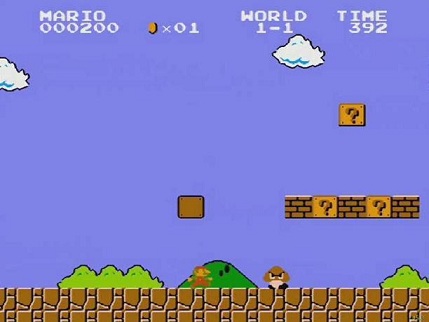
Why Super Mario Bros.? Without a doubt, the most popular franchise (not to mention character) in gaming. It’s just not possible not to know Mario if you’re a gamer.
Why the original? Perhaps a little debate could be had here, but, as I said, a game does not need to be the best in its franchise to appear on this list. The original Super Mario Bros. is considered by many to be the game that saved the whole industry after the US video game market crashed in the early 80s. Of course, that’s a bit of an America-centric view on things, but there is some truth to it. Video games really picked up with the NES, this game being its flagship. Of course, when talking of Super Mario Bros.’ contribution to gaming, one has to mention that it was also the game that truly made the platformer genre mainstream and inspired numerous great games in it, in both the 2D and 3D (where Mario was also one of the pioneers with Mario 64) realms.
6. Tetris (Alexei Pajitnov, PC, 1986)
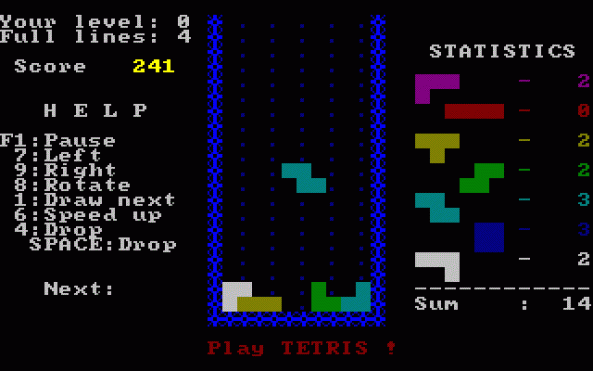
Why Tetris? Surely the game that the appeals the most to non-gamers, it has been played on all kinds of hardware from the 8-bit computers back in the 80s to the Android phones of today… Tetris is the game that gave true shape to the puzzle genre, and is still just as popular today as it ever was. It was also the game that carried the GameBoy (and, arguably, handheld gaming as a whole) to success. The story of the copyright fights related to it is something best left for an article of itself, but it has to be said that the Russian Alexei Pajitnov created something truly incredible and timeless. Above, you can see what the very first version of Tetris looked like. It is freeware and you can play it yourself today by getting it here.
7. Dragon Quest (ChunSoft, NES, 1986)

Why Dragon Quest? A legendary franchise in which the roots of RPGs (especially of the Japanese variety) can be traced.
Why the original? While a mediocre game by today’s standards (some would even call it “terrible” and I’d understand them) and outdone by all the later entries in the series, the original Dragon Quest was the one that laid the foundations upon which the Japanese RPG genre I love so much was built. It was simplistic, you could only control your one character, not a party, the story was simpler than a fairy tale for children, battles were static with the occasional sprite blinking and sound effect, I could go on and on. But it also had the turn-based battle system that we still see even today (in one or another evolved form), the basic town-wilderness-town structure, the dungeons, the bosses… All the groundwork that we see in pretty much all contemporary JRPGs.
8. Arkanoid (Taito, Arcade, 1986)

Why Arkanoid? While Arkanoid is based on Atari’s 1976 Breakout, it is more popular and well-known, especially among people who started in the 8-bit generation or later. While originally an arcade game, its NES port was one of the most recognisable games on the system. Needless to say, there have been some sequels by Taito, as well as countless spin-offs by many different developers on all kinds of devices.
9. Double Dragon (Technos, Arcade, 1987)

Why Double Dragon? Surely, this one has eaten quite a few of your coins… Double Dragon is an absolute classic, the game that practically launched the beat ’em up genre to success, making it a total hit at arcades and later consoles. While Nekketsu Kouha Kunio-Kun, known as Renegade in the West, also by Technos (creators of the amazing 8-bit Nekketsu series), was the first game to introduce horizontal and vertical movement across the field – one of the distinctive features of the genre, Double Dragon was second and the much more successful game that most gamers remember. It even got a facelift version on XBLA a few years ago, with a remake of sorts named Double Dragon Neon coming soon to PSN and XBLA.
Why the original? Again, the choice was easy – later entries in the series were perhaps better games, but the original is a true classic.
10. Mega Man (Capcom, NES, 1987)

Why Mega Man? Mega Man, or Rockman, as he’s known in Japan, is still one of the most popular franchises in gaming, despite Capcom’s recent abandonment of it and its uncertain future after Inafune left the company. With 6 whole installments on the NES, it was one of the series that carried the system and if you had played an NES, chances are you’d played at least one of those 6. Later, Mega Man X become a huge hit on the SNES and X4 was one of the games that made the PlayStation library as amazing as it is. Recently, the original series saw a rebirth with the 9th and 10th installments being downloadable on PSN/XBLA/Wii… But is there any future?
Why the original? I have to admit to a bit of a personal bias here, as the second game is easily more highly regarded by gamers and critics alike. It also sold much better. But the original laid the foundation that later entries merely expanded upon (some of the elements added later were actually already planned for the first game, but ultimately cut). Mega Man was also the first game featuring non-linear level selection, you could play the stages in the order you desired. And, of course, the terrible box art tradition started there. 🙂
11. Contra (Konami, NES, 1988)
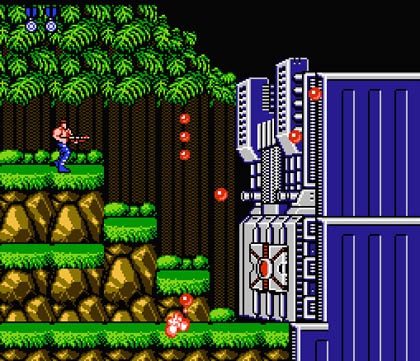
Why Contra? Contra is a very special franchise for gamers, notorious for its difficulty, but offering a fair challenge. It features stellar level design and a variety of weapons making it a blast to play. It was another one of the most popular NES titles that made the 8-bit generation so special. Contra was one of the first franchises where you played as a soldier.
Why this version? While the arcade version came first, I picked the NES version specifically because it is what made the Contra name really a household one. It is a very good adaptation of the arcade game (unlike many others of the period). The first Contra also contained pseudo-3D stages which were quite something for the time. A fact unknown to some is that the first Contra (and also many later ones) was known as “Probotector” in Europe and the main characters were robots, a change made because of the strict German censorship laws.
12. Prince of Persia (Broderbund, Apple II, 1989)

Why Prince of Persia? Prince of Persia is still an active franchise, with high-budget and high-quality installments released regularly. It has changed in many ways since 1989 (one can easily see the difference between the originally blond character and the way The Prince currently looks), but it remains a staple in the gaming culture.
Why the original? The 1989 hit is an emblematic computer game, showing that platformers could be beautiful and done well not only on consoles. The character animations are particularly impressive, creator Jordan Mechner having carefully watched his brother’s movements to replicate them in the game. There are other critically acclaimed games later in the series, especially once it had gone 3D, such as Prince of Persia: The Sands of Time, but the original is a true classic.
13. Street Fighter II (Capcom, Arcade, 1991)

Why Street Fighter? Street Fighter is the first fighting game series that first made the genre really popular. It has managed to maintain the flagship position for the 2D fighting genre for 20 years now.
Why Street Fighter II? The original Street Fighter is relatively unknown and is, quite frankly, not a very good game. The later entries, including the recent Street Fighter IV, have all been successful to one extent or another, but the second game in the series is the one that introduced many mechanics whose improved version still make up the skeleton of every self-respecting 2D fighter. Street Fighter II was also the game that brought the fighting game scene to home consoles, with the SNES and Mega Drive/Genesis versions being pretty good ports of the arcade counterpart.
14. Dune II: The Building of a Dynasty (Westwood, PC, 1992)

Why Dune II? Dune II was the not the first real-time strategy game per se (that would be Herzog Zwei on Mega Drive/Genesis), but it was the one that was noticed and basically started the genre. Like Street Fighter II, it introduced most of the mechanics still used today. Dune later turned into a moderately successful RTS series, becoming the root of Westwood’s Command & Conquer franchise. Sadly, since Emperor: Battle for Dune, we haven’t seen a Dune RTS for more than a decade, and who knows if we ever will again.
15. Super Mario Kart (Nintendo, SNES, 1992)

Why Mario Kart? Kart racing is not one of the biggest, nor most beloved genres, but it’s good for some quick fun. And Mario Kart is the series that comes to mind first when you think of kart racing games.
Why Super Mario Kart? While many will claim it is not the best in the series, the original started the whole thing and everything that came after merely made small changes or improvements. Super Mario Kart also made an impressive use of SNES’ graphical capabilities.
16. Mortal Kombat (Midway, Arcade, 1992)
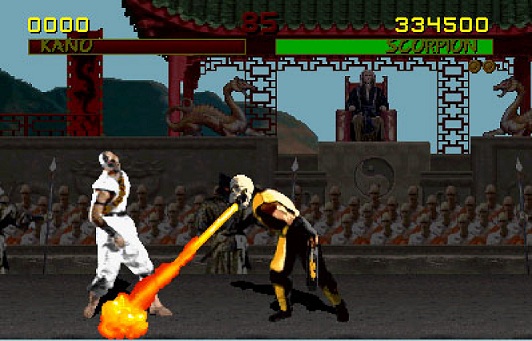
Why Mortal Kombat? The series has become synonymous with violence in games. While far from the best in terms of mechanics (although the latest game certainly is a competitor in that field, as well), Mortal Kombat has always had an easy time attracting fans because of the spectacular fatalities.
Why the original? It was the game that took arcades by storm through introducing fatalities. It was something never seen before in a game, and Mortal Kombat became instant success. The mechanics were a bit clunky, but it didn’t matter. It was all about finishing your opponent off with a glorious move.
17. Sonic the Hedgehog 2 (SEGA, SEGA Mega Drive/Genesis, 1992)

Why Sonic? Heh… SEGA entered the 16-bit era powerfully, pushing a new franchise to compete with Nintendo’s well-established Mario series. They bet on speed, and thus was Sonic born. The Mega Drive/Genesis games were absolute hits, pushing the console ahead of SNES for a long time outside of Japan. Later on, once Sonic entered the 3D realm, things were not so good, but the impact made during the 16-bit days was enough to still keep the blue hedgehog as one of the most recognisable game characters in history.
Why Sonic 2? While the first game was also impressive, the second one truly made the series big and easy to distinguish, introducing the spin dash, Super Sonic, and even the pseudo-3D bonus stages. It also added Tails, Sonic’s loyal sidekick, and a nightmare for all the little brothers out there.
18. Doom (id Software, PC, 1993)

Why Doom? Today, the first-person shooter is easily the genre that gets the most attention, with Call of Duty sales being off the charts. Doom, while again not the first in the genre, was the first game that truly caught the attention of the public. Interestingly, it also included the facial impression of your character alongside your health and ammo – something lost in today’s FPS games.
19. Super Metroid (Intelligent Systems, SNES, 1994)

Why Metroid? One of Nintendo’s biggest franchises, Metroid made a small revolution in gaming when it was revealed that the main character, Samus, was actually a girl. Metroid’s path has had its ups and downs since, with Super Metroid and Metroid Prime being very well critically received, but also with no game to be seen on the Nintendo 64 and the latest entry Other M being hated by many fans. But Metroid remains one of the most loved series.
Why Super Metroid? While there are a few who would argue in favour of Retro Stuidos’ Prime games, most still consider Super Metroid to be the pinnacle of the series. Gunpei Yokoi’s brainchild was an example many later games borrowed ideas from.
20. Earthworm Jim (Shiny Entertainment, SEGA Mega Drive/Genesis, 1994)

Why Earthworm Jim? Perhaps one of the odder choices in the list, but bear with me. In an era where many smaller developers tried to replicate the success of Mario and Sonic by developing games (usually platformers) focused on “mascot”-type characters, Earthworm Jim was perhaps the one that shone the most. The platforming + shooting combo was solid, there was nice variety in the stages, the challenge was great (perhaps even a bit too much at times). But what I loved the most about it was the humour. It was really unique and strange in a good, very good way. The soundtrack by Tommy Tallarico was also great. Earthworm Jim even got his own saturday morning cartoon, following the Mario and Sonic’s footsteps!
Why the original? Well, it’s not a very difficult choice. The second game was also quite impressive with even greater variety in the stages, but it just felt like a continuation of the incredibly fresh setting the first had introduced. And let’s not talk about Earthworm Jim 3D.
21. Donkey Kong Country (Rare, SNES, 1994)
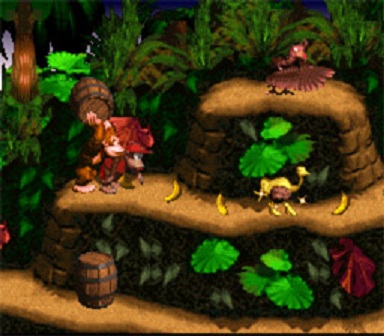
Why Donkey Kong? Donkey Kong was big back when Mario’s name was still Jumpman. The original massive arcade hit was followed by many games about the ape, exploring different ideas and genres throughout the generations. While it’s currently a second-tier franchise at best for Nintendo, it has remained a big name in the gaming community.
Why Donkey Kong Country? Perhaps some would argue that the original arcade game deserves the place on this list more, but I believe Donkey Kong Country is the one. The first big game Rare did as Nintendo’s second party developer, Donkey Kong Country pushed the SNES’ graphics to its limits (something Rare have been known to do since) and quickly gained a following. It played a key role in the SNES taking back the top position in North America’s 16-bit race from Sonic and the Mega Drive/Genesis.
22. Chrono Trigger (SquareSoft, SNES, 1995)

Why Chrono Trigger? Two words are enough to explain it: “Time traveling.” Chrono Trigger was the first big game that did this, and it was a mechanic in an incredible story to boot. A SquareSoft “dream team” being assembled especially for it, it is still one of the best RPGs ever created. The characters were drawn by Dragonball’s creator Akira Toriyama. It had all the prerequisites to become a massive hit and it delivered. It even got rid of the genre’s trademarked random battles, opting instead for enemies visible (and avoidable) on screen. Even if RPGs are not your thing, this is one of the games you should consider playing.
23. Duke Nukem 3D (3D Realms, PC, 1996)

Why Duke Nukem? Gaming has become a major part of popular culture and Duke Nukem is one of the reasons. Resembling Arnold Schwarzenegger and known for the unique arrogant humour that is loved by millions and hated probably by just as many, the Duke’s legacy continues to live today, even if the game that brought him back from the dead, Duke Nukem Forever, was an easy target that critics didn’t miss the chance to bash.
Why Duke Nukem 3D? After two entertaining, but ultimately not amazing 2D shooter-platformers, Duke made his real impact with his third game and first in three dimensions. Blasting aliens with a variety of guns was combined with entertaining activities rarely seen in a game like going to the bathroom and even watching and tipping strippers. And that trash talking! With Gearbox taking over, I believe in the franchise’s future. Always bet on Duke! 🙂
24. Pokemon Red/Blue (Game Freak, Game Boy, 1996)
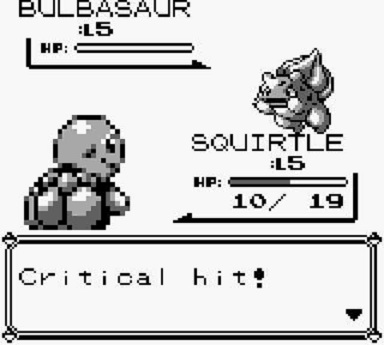
Why Pokemon? One of the real no-brainers on the list, Pokemon is still one of the most successful franchises, often even selling two copies of the same game (if under a different name) to the same people. Easily the most mainstream RPG series, it is a true cultural phenomenon, and while it draws criticism for getting stale 16 years after it was introduced, I believe it will continue to sell millions of copies for many years to come.
Why the original? Obvious choice, when we’re talking about a franchise often criticised for milking the same old concept. Red/Blue are the most beloved games in the series by its fans and probably always will be. It was also the Pokemon game where you could really “catch ’em all” without needing to jump through several hoops (and pay more money) to do so. The thrill when a wild Pokemon is shaking in your ball is something no gamer can forget.
25. Tomb Raider (Core Design, PC/SEGA Saturn, 1996)

Why Tomb Raider? Much like Mortal Kombat brought brutal levels of violence in video games, Tomb Raider did much to promote the sex appeal aspect emphasised quite heavily nowadays. With a beautiful body and an especially noticeable chest, Lara Croft quickly became a pop culture icon that many gamers fantasised about. The trend ultimately culminated with the two Tomb Raider movies starring the sexy Angelina Jolie.
Why the original? Crystal Dynamics breathed new life into the series after Core Design’s demise and created several high quality titles, but the original was the one that introduced Lara and the whole concept. Fun fact: While it was a major factor in PlayStation’s success, Tomb Raider actually debuted on the rival SEGA Saturn console (and PC).
CONTINUE TO PART 2
Maybe you don’t agree with some choices, or you think some important franchises that aren’t coming up in the second part were missed? Post a comment and let the world know!
I’m surprised you didn’t list any Final Fantasy games yet.
I think there’s a lot of instances where you inserted a view of your own views and assumed them to be unanimous, and it leaves a bad taste in my mouth to see an article released only half-complete, but other than that, this was very well-researched and solidly written. Good work all around.
Thank God we can’t edit our replies, or else I might not look silly when I make a typo in the same sentence in which I comment on your writing.
Good stuff Vlado, I enjoyed the read.
Thanks a lot, guys! The second part is coming soon, maybe already tomorrow.
Pretty good list and a fun read. The one game I’d argue against is Duck Hunt, since it’s not that great and remembered mostly as an inside joke among those of us who grew up with the NES. Maybe Space Gun or Jurassic Park is a better choice for a light gun game.